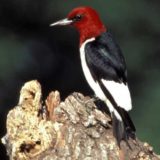
One of the most common birds that are seen at the feeders during the winter in Northeast Ohio are woodpeckers. Ohio is home to seven species of woodpeckers, the Downy being the most common. The largest is the Pileated with a wingspan of almost 30 inches. The most majestic, in my mind, is the Red-headed. All seven species are insect eaters but only the Yellow-bellied sapsucker feed on sap from holes that are drilled into trees. During the winter, five of the seven species will switch to eating seed or nuts along with suet. Two species are migratory and fly south for the winter, the Northern flicker and the sapsucker. There are 180 species of woodpeckers that make up the the family Picidae (order Piciformes). Woodpeckers occur nearly worldwide, except in the region of Australia and New Guinea, and are most abundant in South America and Southeast Asia. Some woodpeckers are tree specific, the Red-cockaded woodpecker can only live in mature pine forests in the southeastern United States. One species of woodpecker, the Acorn woodpecker caches acorns in the holes it drills in trees and eats the acorns throughout the winter. One of the most famous woodpeckers, Woody Woodpecker, was modeled after the now thought extinct ivory-billed woodpecker.
As we all know, woodpeckers are mother nature’s chisels. They use their beak to excavate their homes, look for food and communicate by drumming on trees. It is estimated that woodpeckers tap or “drum” on trees 8,000-12,000 times per day. This is especially true during courtship and territorial disputes between males. Woodpeckers make a new home each year by chiseling out cavities in trees. Most woodpecker holes are perfectly round and vary in size based on the size of the woodpecker. However, the opening of the pileated woodpecker is oblong due to the larger size of the bird.
What makes these birds so amazing, at least to me, are the adaptions that allow them to flourish in the forest community. To begin with, most passerine (perching) birds have one toe pointing back and three pointing forward on each foot, woodpeckers have two sharply clawed toes pointing in each direction to help them grasp the sides of trees and balance while they hammer. This toe formation is called zygodactal. Additionally, woodpeckers also have stiffened tail feathers, which they press against a tree surface to help support their weight. (we will discuss that later)
However, one of the most fascinating things about woodpeckers is their tongues. Woodpeckers’ tongues are usually about twice the length of their bill so that they can reach for insects inside the holes they peck out. When not in use, the long tongue curls around the back of the head between the skull and the skin. The tongue is actually wrapped up in a set of bones and muscle called the hyoid apparatus. In some cases the tongues can go five inches past the tip of the bill. Their tongues are also sticky. Most woodpeckers have either barbed tongues or sticky saliva that helps them pull out insects they find in their holes.
Learn more about woodpecker tongues at Birdwatching Magazine
The barbs on the tongue face back toward the woodpecker much like the barbs on a fishing hook so the insects can’t wiggle off.
The second most intriguing aspect of woodpeckers is the ability to hammer into wood and throw aside the chips, whether excavating a nest cavity or digging for tasty morsels of food. Research has shown that the woodpecker’s head strikes with at least 1,000 times the force of gravity, yet the bird suffers no apparent harm. By contrast, any human who experienced a similar impact would surely die. Several factors contribute to the bird’s shock-absorbing capability. One is a self-sharpening, chisel-like beak that slides back and forth into wood rather than stopping abruptly. Another is exceptionally strong neck muscles. When you observe a woodpecker on a tree, it is in an upright position with its tail acting as a brace. When the bird begins hammering, the muscles in its neck absorb the shock of the pecking from the head and transmits it into the shoulders, upper torso, into the tail, and then back into the tree. It’s a perfect example of what is called “circular dispersion” of energy. Finally if you look at the skull of a woodpecker you’ll notice that their brain case is elongated with reduced space in the skull. The inside of the skull also has layers of spongy bone that helps in absorbing the shock. The orientation of the brain itself is also important, since it allows the force to be spread over a larger surface area. With the greater surface area of the brain it allows for the absorption of the energy at impact.
So next time you see or hear a woodpecker eating or drumming you can appreciate these amazing adaptions.











